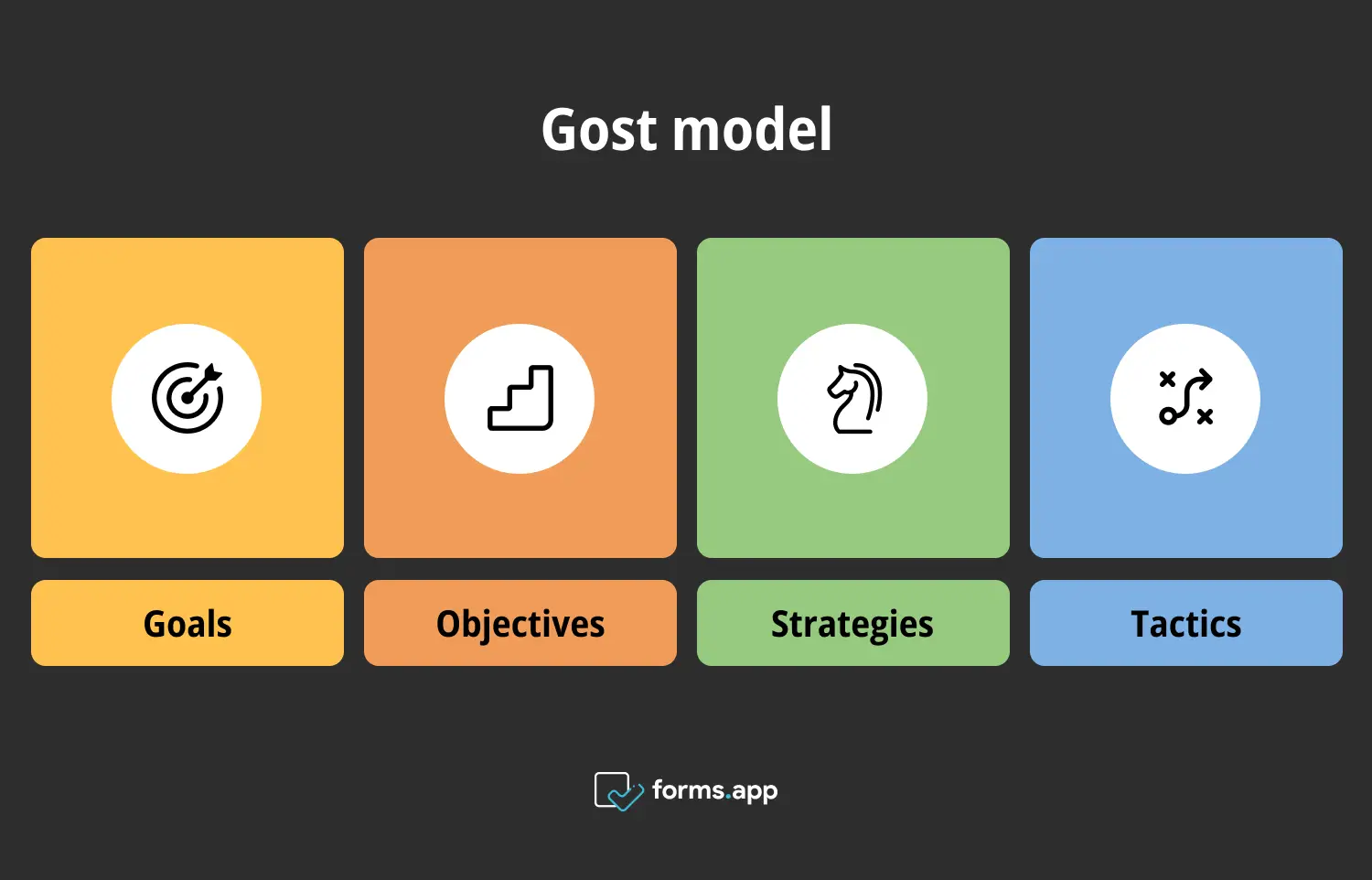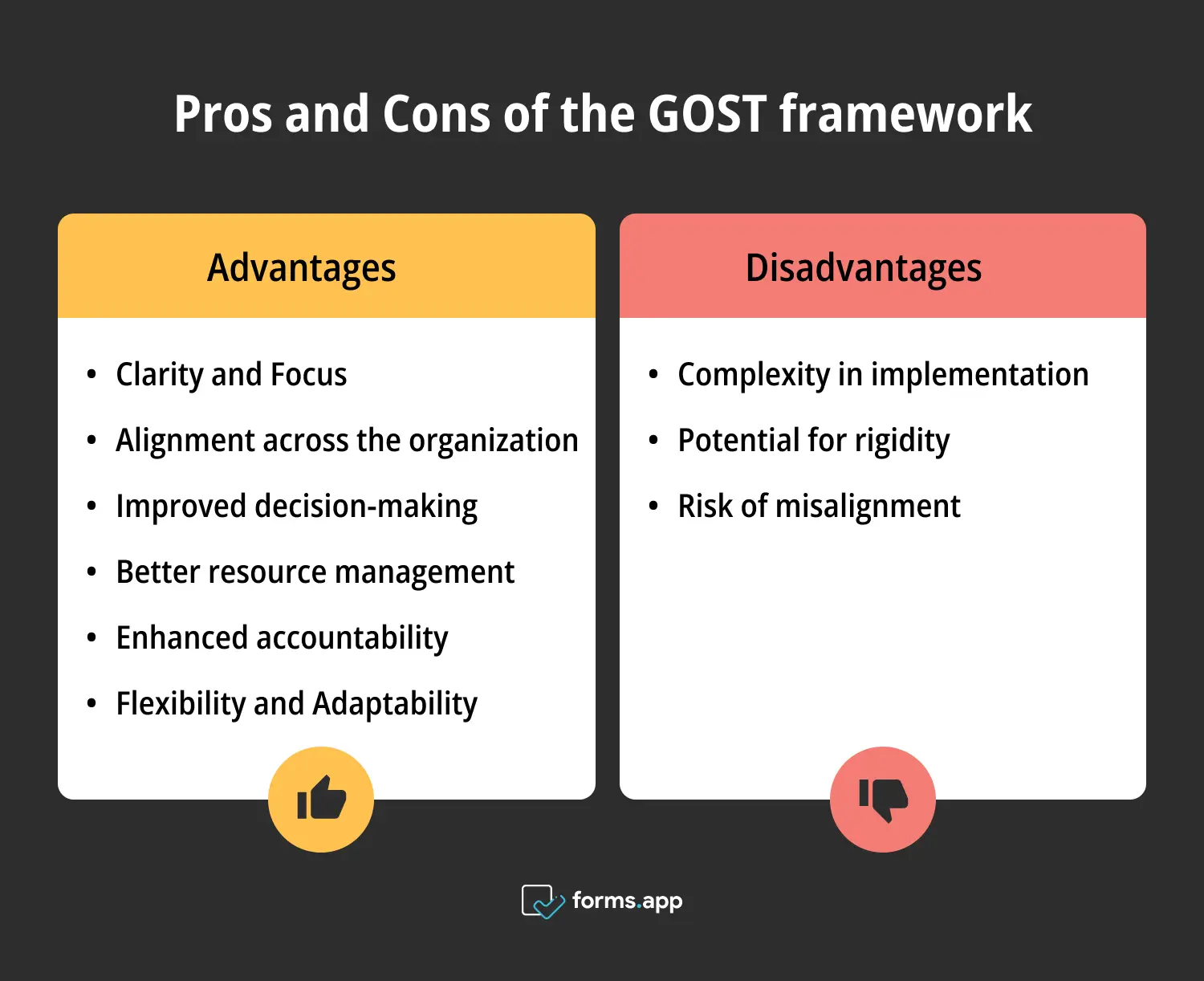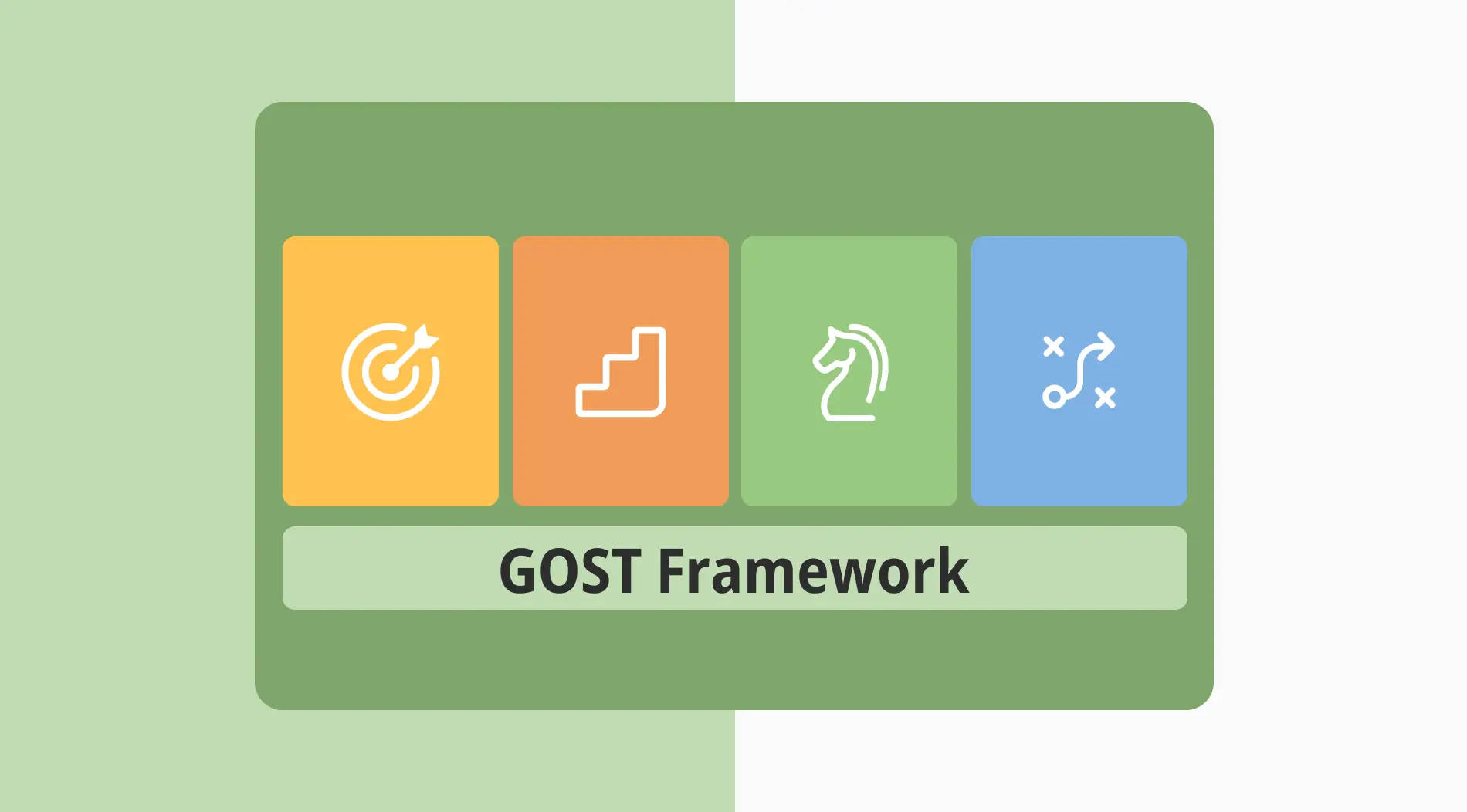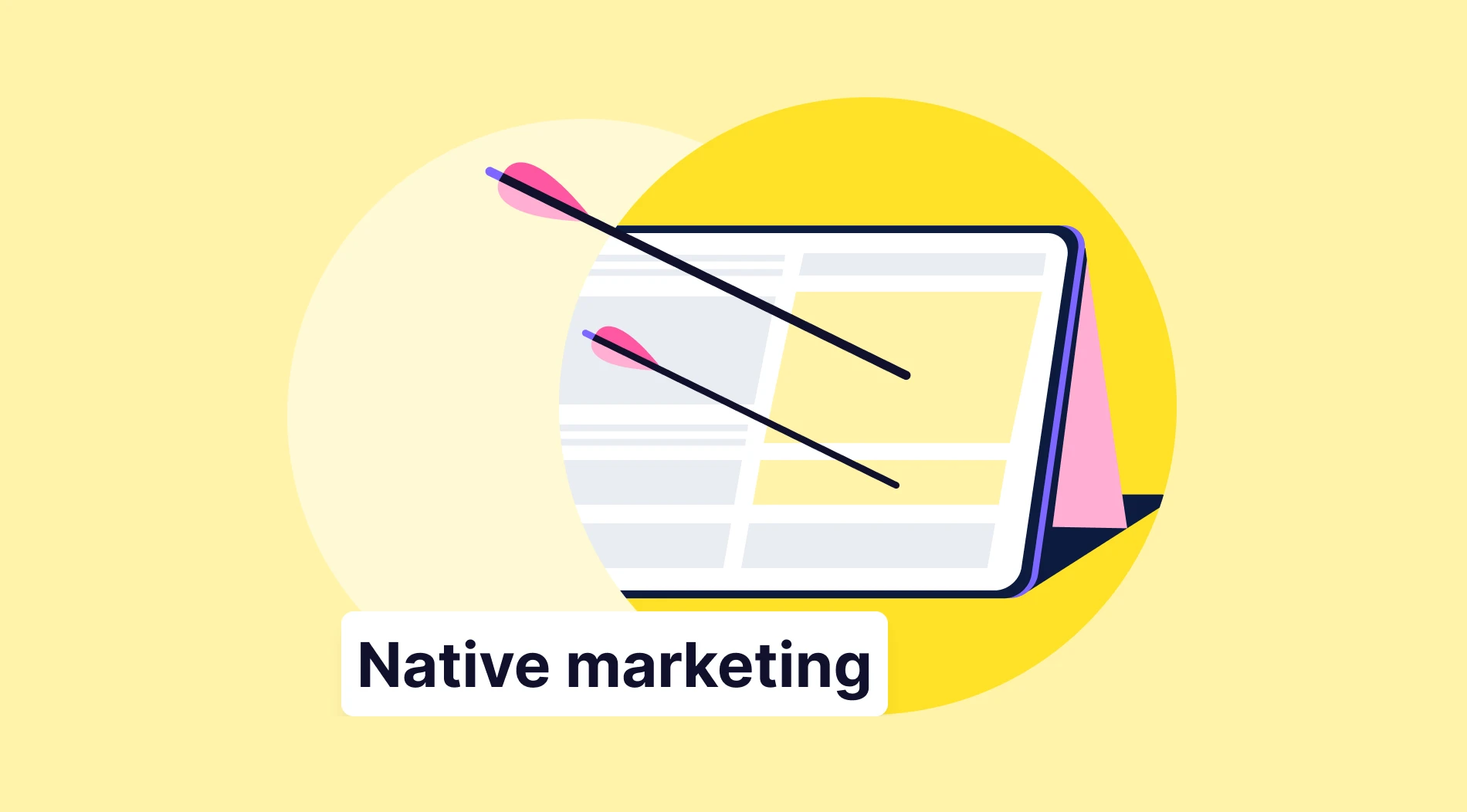In today’s competitive business world, frameworks and models are essential. They guide your company toward success by providing clear structures and strategic paths. These tools help your business organize its goals, develop processes, and make informed decisions. They not only ensure alignment across teams but also help you adapt to market dynamics. This makes them indispensable for business strategies.
This article is an ultimate guide to one of these models, the GOST framework. It is a powerful tool for strategic planning in business. We will explore how to use it and discuss the pros and cons. We will also answer some common questions. After reading this article, you will start believing in GOSTs. 👻
What is the GOST model?
The GOST framework, or the GOST model, is a strategic planning tool that helps businesses align their actions with their long-term vision.
The acronym stands for Goals, Objectives, Strategies, and Tactics. In this model, you break down broad goals into actionable steps. The GOST framework ensures that every part of your organization works towards a common purpose.
The GOST framework is a versatile tool across different levels of business, from corporate strategy to individual projects. It provides a clear structure and makes the complex decision-making processes easier. It also enhances the efficiency of their execution, making it applicable among your departments and helping you maintain alignment with them.
GOST model explained: Components and differences
The GOST framework breaks down complex business goals into manageable parts, making it easier to plan, execute, and achieve desired outcomes. Now, let’s dive into the framework and explore it in detail. The acronym GOST has four components: Goals, Objectives, Strategies, and Tasks. Here are also the goals, objectives, strategies, and tactics’ examples:

GOST model
Goals
Goals are the outcomes that a business wants to achieve. They represent the long-term goals and are the foundation of the GOST framework. Goals provide direction for your entire organization. They guide decision-making and align efforts across all levels. They are broad, aspirational, and often reflect your company’s mission and values.
Your company may set a goal to become the industry leader in customer satisfaction. This goal provides a clear target for the business and sets the tone for all other activities. It is essential to ensure that your goals are realistic but challenging. This inspires your organization to go beyond its current capabilities while staying realistic.
✏️ Example: Walmart, a regional retail chain sets a goal to expand its market presence by becoming the top retailer in its category within the next five years. This goal drives the company’s focus on improving customer service, expanding product offerings and increasing brand visibility. To achieve this, the company will need to align all its resources and strategies towards this ambitious target.
Objectives
Objectives are the specific, measurable, achievable steps that a business must take to achieve its goals. They break down the broader goals into actionable targets that you can track and measure. Objectives often have time constraints and provide a clear path to achieve your company’s long-term vision.
You can have an objective of increasing sales by 15% within the next year. Objectives provide the milestones needed to track progress toward your larger goal. They are critical in ensuring that the business stays on course and can adjust strategies as needed to meet the targets. By setting clear, measurable objectives, your company can evaluate its progress.
✏️ Example: Walmart sets an objective to open 10 new stores in high-growth areas within the next 18 months. This objective is specific and measurable and directly contributes to the overall goal of market expansion. By focusing on targeted growth areas, the company can strategically increase its market share, driving toward its long-term vision of becoming the industry leader.
Strategies
Strategies are high-level plans that outline how a business will achieve its objectives. They provide a roadmap for your organization, detailing the approach to meet the objectives. Strategies can include the allocation of resources, the identification of key initiatives, and the development of a timeline for execution.
Your strategy may involve launching a new marketing campaign to attract more customers or expanding into new markets. Strategies bridge the gap between the objectives and tactics, ensuring that you align your company’s actions with the overall goals. They are essential for effective allocation of resources.
✏️ Example: Walmart decides to implement a strategy focused on enhancing its online presence and leveraging data analytics to better understand customer behavior. This strategy includes launching a new e-commerce platform, optimizing its website for mobile users and investing in digital marketing campaigns. By focusing on digital transformation, it aims to attract a broader audience.
Tactics
Tactics are the specific actions taken to execute the strategies. They are the daily activities that move your business closer to its objectives. Tactics are detailed, actionable steps ensuring that you implement the strategies effectively. It may vary from publishing weekly blog posts on industry trends as part of a content marketing strategy.
Tactics are where you take action. They translate the strategies into practical, executable tasks. These actions are often short-term and focus on achieving immediate results that contribute to the broader objectives and goals. Tactics require careful planning and execution to ensure that they align with the overall strategy and contribute to your company’s success.
✏️ Example: Walmart decides to use tactics such as launching targeted email campaigns, offering an exclusive online promotion, and regularly updating its blog with relevant content. These tactics aim to increase website traffic, improve customer retention, and boost online sales. Walmart executes these specific actions and ensures that it drives progress toward its broader objectives and goals.
Key Differences Between Goals, Objectives, Strategies, and Tactics
The four main components of the GOST framework are connected with each other. They are somewhat similar and, in some cases, interchangeable. However, there are some key nuances/differences between each component. Each of them builds on the previous one and creates a structured path to success.
- Goals: They represent the broad, long-term vision a company aims to achieve.
- Objectives: They are specific, measurable steps to guide progress toward these goals.
- Strategies: They outline the high-level plans for how to reach the objectives.
- Tactics: They are actionable, daily tasks to execute the strategies.
How can you apply the GOST framework in business?
Now, let’s delve into how to apply the GOST framework effectively. It requires understanding its adaptability across various scales: corporate, program, and project levels. Whether you are managing a company initiative, steering a progra,m or executing a project, the GOST framework offers you a structured approach to align efforts and achieve success at every scale.
1. GOST framework at the corporate scale
At the corporate level, the GOST framework helps you align your entire organization with your long-term vision. You set goals to reflect your company’s mission and aspirations, while your objectives provide measurable targets. Strategies at this level involve high-level decisions and tactics, which are the specific initiatives.
The GOST framework ensures that you align all corporate actions with your company’s goals. It creates a cohesive and focused organization. It helps you maintain consistency across all departments and ensures that your teams are working towards the same objectives.
2. GOST framework at program scale
When you apply the GOST model at the program level, it ensures that you align all projects with the broader organizational goals. You set goals for the program to contribute to the company’s overall objectives. Program-level objectives break down these goals into achievable targets. The strategies outline how the program will achieve those objectives.
When it comes to tactics, there will be specific projects and initiatives within the program to execute the strategies. The GOST framework at this scale helps in managing multiple projects at the same time. This ensures that they all contribute to the organization’s goals.
3. GOST framework at project scale
At the project level, the GOST framework provides a detailed roadmap for project execution. Goals for the project align with the program and corporate goals, ensuring consistency across the organization. You can set objectives to achieve specific outcomes within the project, such as completing milestones or delivering a product on time.
Strategies will outline the approach to achieve these objectives while tactics are the daily activities to move the project forward. The GOST framework at the project level helps you maintain focus, manage resources effectively, and ensure that your project contributes to the organization’s broader goals.
Pros and cons of the GOST framework
While we have briefly touched upon the advantages of the GOST framework, let’s take a look at them to understand the versatility of this model. Like any other model, the GOST framework also has some cons, and you need to take these into account before applying it to your business. Here are the pros and cons of the GOST framework:

Advantages and disadvantages of the GOST framework
Pros
➕Clarity and Focus: The GOST template provides clarity by breaking down broad goals into specific, actionable steps. This structured approach helps businesses maintain focus on what truly matters, ensuring that every action taken contributes to the overall vision.
➕Alignment across the organization: One of the key advantages of the GOST framework is its ability to align all parts of the organization with the company’s goals. From top management to frontline employees, everyone works towards the same objectives, creating a cohesive and unified organization.
➕Improved decision-making: The GOST model template enhances decision-making by providing a clear structure for evaluating options. By aligning decisions with the company’s goals, objectives, strategies, and tactics, businesses can make informed choices that support their long-term vision.
➕Better resource management: By providing a clear roadmap for achieving business goals, the GOST Framework helps in optimizing resource allocation. Businesses can allocate resources more effectively by focusing on the strategies and tactics that will have the most significant impact on their objectives. Integrating resource management tools into this framework will further aid this process and provide further impact.
➕Enhanced accountability: The GOST Framework improves accountability by clearly defining goals, objectives, strategies, and tactics. Each team member understands their role in achieving the business objectives, leading to better accountability and performance. The framework provides a basis for measuring progress.
➕Flexibility and Adaptability: Despite its structured approach, the GOST Framework is flexible and adaptable to changing business environments. Businesses can adjust their goals, objectives, strategies, and tactics as needed, ensuring that they remain aligned with their long-term vision.
Cons
➖Complexity in implementation: While the GOST Framework provides a clear structure, its implementation can be complex, especially for large organizations. The process of setting goals, objectives, strategies, and tactics requires careful planning and coordination, which can be time-consuming and resource-intensive.
➖Potential for rigidity: Although the GOST Framework is designed to be flexible, there is a risk of it becoming rigid if not managed properly. Businesses may become too focused on following the framework to the letter, leading to a lack of adaptability in response to changing circumstances.
➖Risk of misalignment: If not implemented correctly, there is a risk that the GOST Framework may lead to misalignment within the organization. For example, if goals and objectives are not clearly communicated or understood by all teams, different parts of the organization may end up working towards conflicting priorities.
Frequently asked questions about the GOST Framework
Last but not least, let’s answer some of the most frequently asked questions about the GOST framework. Understanding the brief answers to these questions will help you get a clearer comprehension of the subject and enable you to use the GOST framework effectively in your business:
Goals are broad, long-term outcomes that a business aims to achieve, representing its overall vision. Objectives, on the other hand, are specific, measurable targets that help in achieving those goals. While goals provide direction, objectives break down the goals into actionable, trackable, and measurable steps, ensuring progress toward the broader vision.
The GOST framework focuses on breaking down goals into objectives, strategies, and tactics. It provides a detailed roadmap for achieving business outcomes. OGSM (Objectives, Goals, Strategies, and Measures) also provides a structured approach but includes specific measures to track progress. While both frameworks aim to align actions with business goals, OGSM places more emphasis on measurable outcomes.
Whether the GOST model is better than OGSM depends on the specific needs of the business. GOST is ideal for businesses needing a clear, detailed roadmap for achieving their goals. OGSM is better for organizations requiring a strong focus on measurable outcomes. Both models have their strengths and can be effective depending on the context.
High-level details in the GOST model refer to the broader goals and strategies guiding the overall direction of the business. Low-level details, on the other hand, are the specific objectives and tactics breaking down these high-level elements into actionable steps. High-level details provide the vision, while low-level details ensure that the vision is executed effectively.
GOST and OKR (Objectives and Key Results) both focus on aligning business actions with goals, but they differ in approach. GOST breaks down the goals into objectives, strategies, and tactics, providing a detailed roadmap for execution. OKR, on the other hand, emphasizes setting ambitious objectives and defining key results to measure progress. OKR is often more flexible and iterative.
Common challenges of implementing the GOST model include the complexity of the framework, potential for rigidity and risk of misalignment. Businesses may struggle with setting clear and achievable goals, coordinating across teams and maintaining flexibility. To overcome these challenges, it’s essential to ensure clear communication, regular review and adaptability in applying the framework.
Wrapping it up
In conclusion, the GOST framework is a powerful tool for strategic planning, offering clarity, alignment, and focus across your organization. You can break down broad goals into specific objectives, strategies, and tactics. It provides a structured approach to achieving your business outcomes. The framework enhances decision-making, resource management, and accountability, making it an invaluable asset for businesses of all sizes.
Today, we have explored the GOST framework in detail, covering its components, applications, and drawbacks. We have also answered some common queries to help you better understand the strategic planning tool. Start implementing the GOST model in your business today and see the benefits for yourself!
Fatih is a content writer at forms.app and a translator specializing in many text domains, including medical, legal, and technical. He loves studying foreign languages. Fatih especially likes to create content about program management, organizational models, and planning tools.



